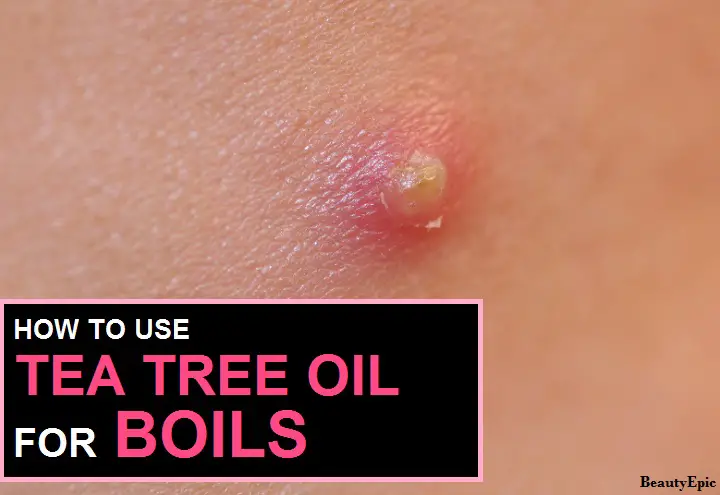
Important: This article is for informational purposes only. Please read our full disclaimer for more details.
Boils can be described as pimples with puss inside, mainly caused due to blockage in the sweat glands or hair follicles. They are bacterial infection caused in hair follicles due to bacterial deposits. Boils can appear anywhere on the body and can be really painful. Tea tree oil, a very widely found ingredient is known to be beneficial to treat boils. Let us read to know how to use tea tree oil for boils.
Article Contains
Does Tea Tree oil Help Boils?

Besides curing acne, cold sores, chicken pox and fungal infections, it also works wonders to prevent boils.
- It is safe and effective.
- It has anti bacterial and anti fungal properties.
- It is easily absorbed by the skin.
- The anti-inflammatory property of tea tree oil can help reduce the pain.
How to Use Tea Tree Oil for Boils
Tea tree oil help to kill bacteria and fungus as it is full of antibacterial, anti fungal and antiseptic properties. Few methods of using tea tree oil for boils are listed below.
1. Apply Tea Tree oil to Boil
You’ll need:
- cotton swab
- 1 tablespoon of tea tree oil
Preparation time: 2 minutes.
How to do:
- Dip a cotton swab in a tablespoon of tea tree oil
- Apply to the affected area 2-3 times a day for few weeks till the boil vanishes.
Repetitions: Follow this process 2-3 times a day.
[ Read: How to Use Epsom Salt for Boils ]
2. Sea Salt and Tea Tree oil for Boils

You’ll need:
- sea salt
- few drops of tea tree oil
- water
Preparation time: 5 minutes.
How to do:
- lean the boil with a cloth.
- Soak the cloth in warm sea salt water.
- Place the cloth on the boil as a compressor for few minutes.
- Put few drops of tea tree oil and gently massage it.
- Cover the boil.
Repetitions: This should be repeated 2-3 times a day.
[ Read: How to Treat Boils with Turmeric ]
3. Lavender oil and Tea Tree oil for Boils
You’ll need:
- 1 bowl of hot water
- tea tree oil
- lavender oil
Preparation time: 5 minutes.
How to do:
- Take a bowl of hot water and add few drops of tea tree and lavender oil in it.
- Give it a good stir and then soak a cloth in it.
- Squeeze out the excess water and cover the boil for 15 minutes.
- Wipe the pus and apply tea tree oil to clean the infection.
Repetitions: Do this thrice in a day.
[ Read: How to Get Rid of Boils with Castor oil ]
4. Coconut oil and Tea Tree oil for Boils
You’ll need:
- 1 tablespoon of coconut oil
- 5 drops of tea tree oil
- 5 drops of frankincense oil
Preparation time: 5 minutes.
How to do:
- Take coconut oil, tea tree oil and frankincense oil and mix them all together.
- Apply the solution on the affected area with a cotton swab.
- After few minutes, use warm water to clean the area.
Repetitions: This regime should be done twice a day.
Tips & Precautions
- It is vital to keep the skin clean so that the boil doesn’t spread to other areas.
- Antibacterial soap should be used for bathing.
- It is important to use scrubs occasionally to keep the pores open and remove blockages.
- Wear clean clothes and use clean towel. Wash any towel that comes in direct contact with the boil to avoid spreading the infection.
- A patch test is always recommended to avoid the occurrence of allergies.
- Do not gulp down tea tree oil directly as it can lead to unsteadiness, confusion and coma.
- Pregnant and breast feeding women should be careful since ingesting tea tree oil is considered to be toxic.
Although there is no direct evidence that applying tea tree oil helps in curing the boils, but various studies in the lab and on animals have proved that tea tree oil is capable of killing staphylococcus bacteria that causes boils. Hence, many people opt for tea tree oil vis-à-vis any antibiotic cream or ointment.
However for very large, infected boils it is advisable to see the doctor or it may lead to fever and fatigue.
You Might Also Like:
- The 8 Effective Home Remedies for Boils
- Apple Cider Vinegar For Boils
- 7 Best Products For Lupus Skin
Image:- 1















